As is typical for much of Greece, morning winds are lighter than afternoon. If you need to go up-wind, it is best to leave early. At 7 am on the morning we would make our way to the northwest tip of Crete, we were tossing off our stern lines, raising our anchor and heading out of the charming harbor of Chania. The winds had been erratic and strong for the previous couple days, so we expected it to be a rough trip.


As you can see from the map of western Crete (upper map), there are two long peninsulas that stretch straight northward from the predominantly East-West coastline. Because we departed from Chania, we needed to head northwest in order to clear the headland of the first peninsula before we would get our first view of the island of Gramvousa in the distance. The cliffs of headlands were so steep that waves rebounded off of them causing confused and sloppy seas. Combining this with a northwest wind meant we were motoring for most of the trip, making it an even more uncomfortable journey. Neither of us felt great since we only had three hours of sleep the night before; we invited a Belgian couple from the boat next to us in Chania over for some adult beverages after they put their young children to bed. We enjoyed our conversation to such an extent that we delayed our bed time! I’m sure they also had a tough morning since they had to get a family of 6 headed to the airport before 6 am … yikes! They were off before our feet even touched the floor in the morning.
As we rounded the northern-most point of Crete, we could raise sails and take the waves on our starboard side, slightly aft of our beam. This meant a much more comfortable ride even though the seas were still big and inconsistent. This rugged coastline of Crete is undeveloped and we each felt like we were heading towards the edge of the earth (though we are NOT flat-earthers, I assure you!!!) The sea to the west of Crete stretches for hundreds of miles before you again reach land in Tunisia! Libya and Egypt are a couple hundred miles south of Crete and Greece’s Peloponnesus is almost 100 miles to the northwest. Our turn to the southwest to reach the anchorage on the south side of Gramvousa Island corresponded with a loss of cell service, making this remote region feel even further from civilization.
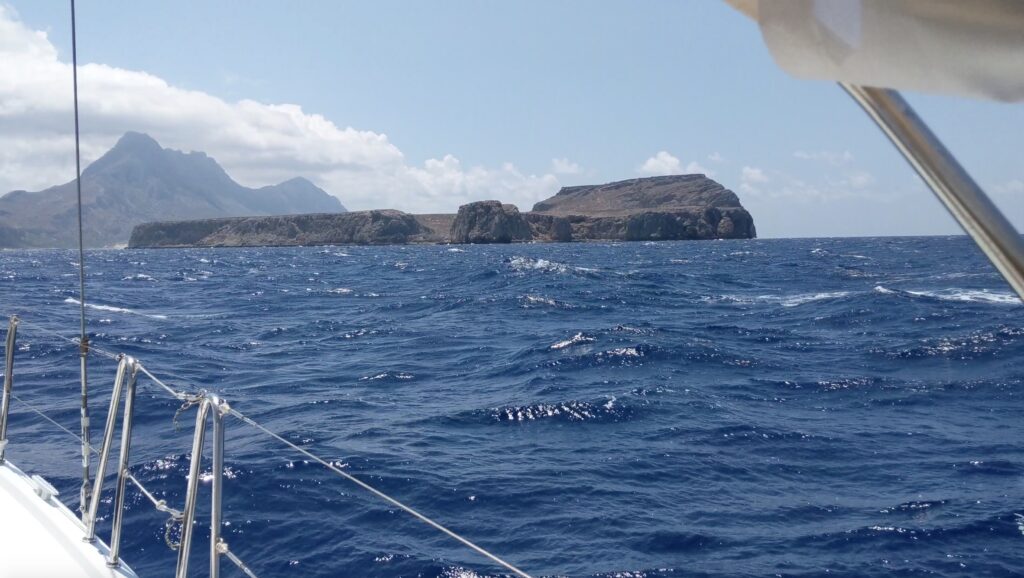
As we approached a protected spot to drop our anchor, we saw several mooring buoys that are likely used by day tripper boats. Even though the area was quite large, these buoys made it difficult to find enough room to swing on anchor. Eventually, we picked our spot, settled in and started to relax after having been tossed about for so many hours. The surroundings were stunning and there is lots to explore nearby; however, at that moment, we were exhausted. Not typically nappers, today would be an exception. We grabbed our pillows and laid down on the cockpit bench seats. No sooner had we shut our eyes than we heard what had to be a sizeable boat rounding the southern point. Sure enough, a ship was coming into view and we recalled learning that twice a day large tour boats arrive and release their scurrying passengers for an hour on shore. As soon as one ship departs, the other comes steaming into view. They convert this quiet, rustic hide-away into a bustling vacation destination for a couple hours each afternoon and the conversion is immediate and intense! We couldn’t believe the size of this thing compared to the tiny dock to which they intended to tie off. Even though we were tucked quite a ways away, we now wondered if they would have enough room to maneuver.
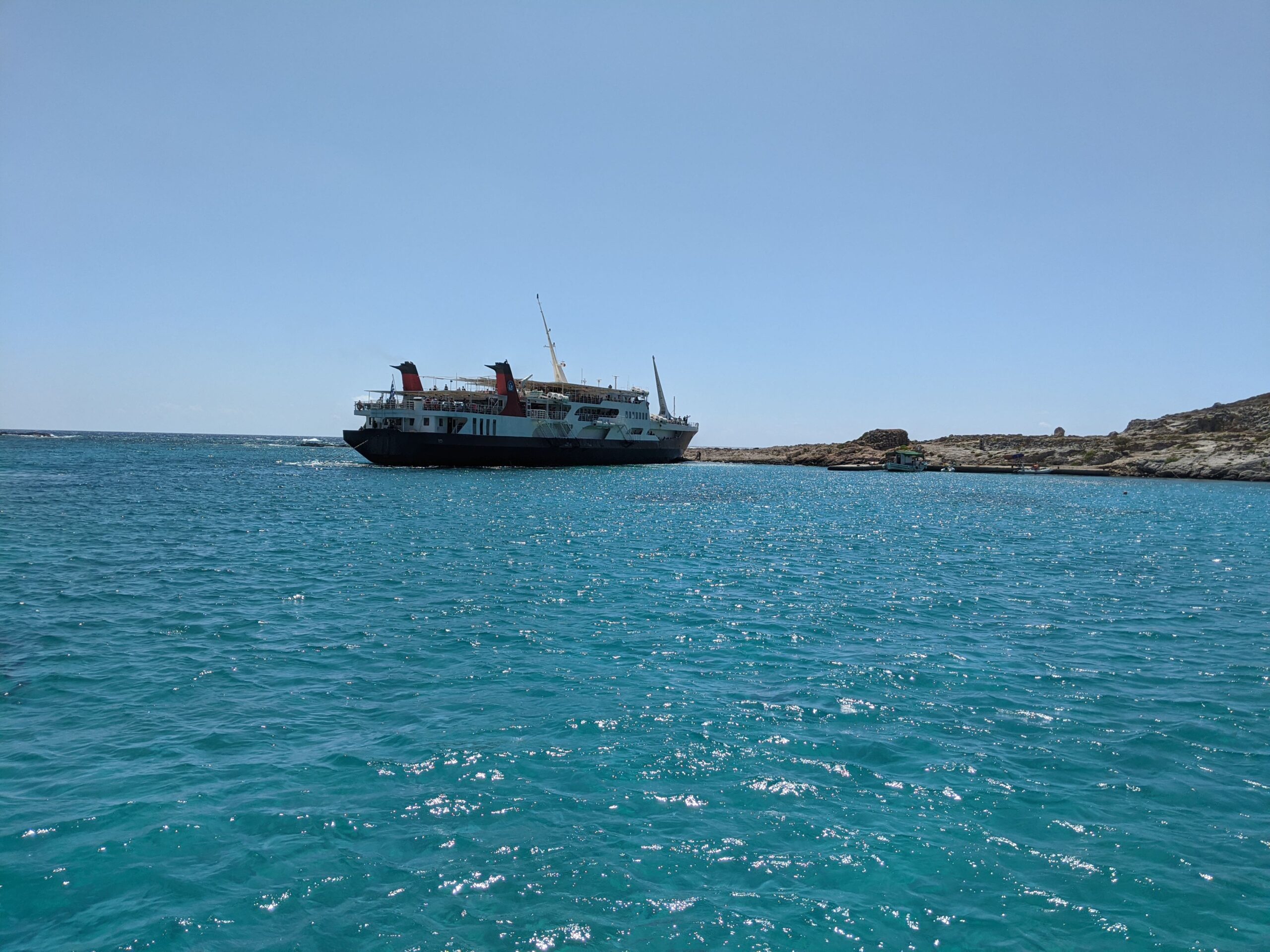
The ship captain took his bow close to one of the mooring buoys while deck hands swiftly hauled up a thick line connected to a much thicker line which they secured to the bow cleats. The captain then turned the large ship on a dime and placed his stern against the seemingly inadequate landing! Ok, that was impressive but today was quiet in this harbor compared to pictures we’ve seen when it is full of visiting yachts and day tripper boats. Maybe now we could close our eyes for a quick nap?
By the time the second ship loaded up their passengers, dropped their lines and headed out of the small harbor, we were rested and ready for our shore expedition. We had already decided we needed at least two nights here and this calmed the urgency to see everything right away. We took the experiences as they presented themselves. The early-evening light was terrific, so we enjoyed a simple dinner in our cockpit and soaked in the sights and the cooling breeze before taking our dinghy to the small harbor’s landing.
There is a high plateau of land on the hilltop above that provides a 360-degree vantage point of the surrounding sea. This made for a perfect place for a citadel and what an impressive one sat high above us! The steep sides of the fortress blended seamlessly with the cliffs below. We walked up the path toward this majestic structure but stopped at the saddle of the ridge to save the visit to the citadel for full daylight hours.
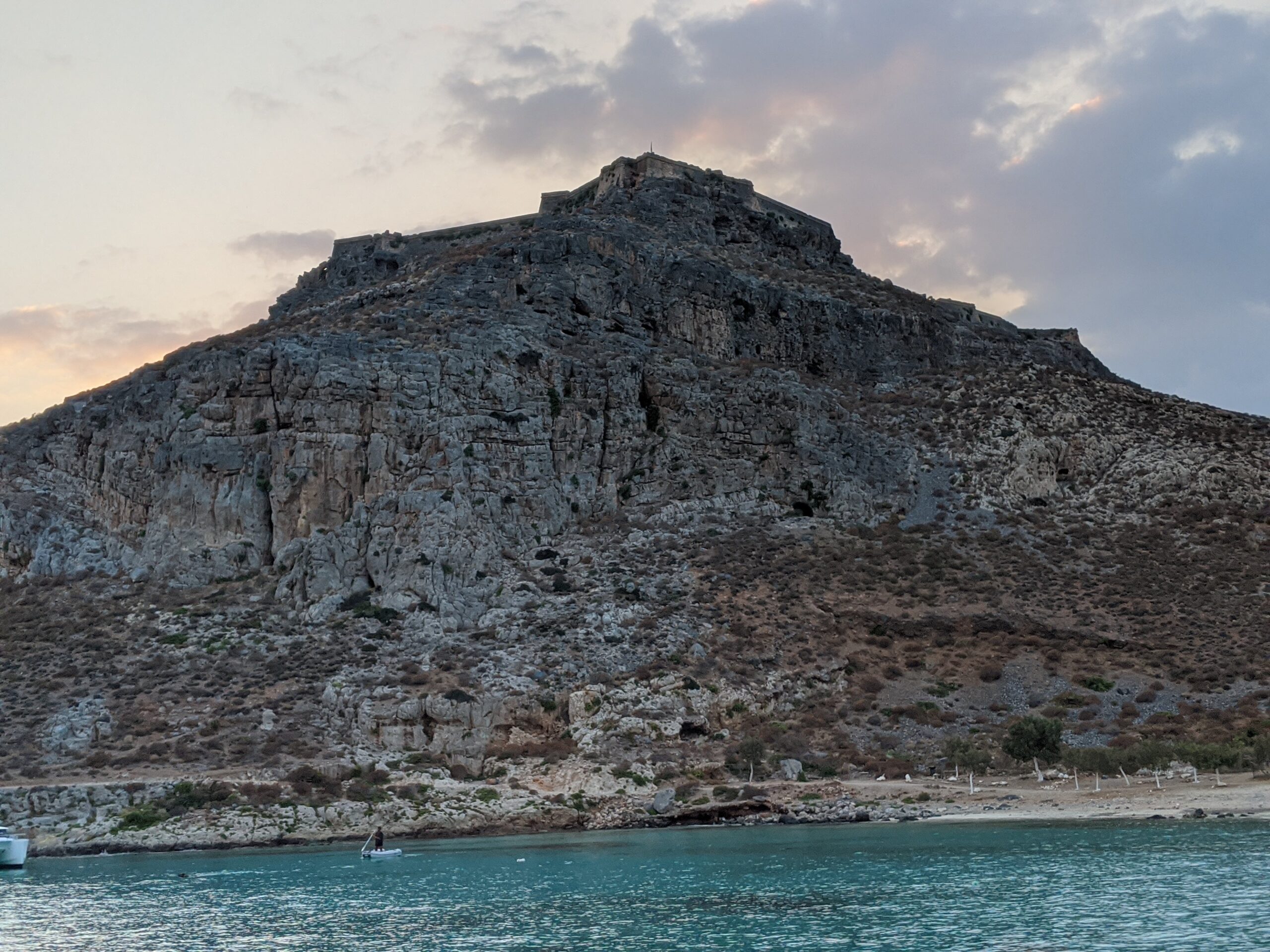
The sun was about to set and we wanted to see it from sea level, which was the right choice. Having the turbulent western-facing waters lashing against the shore in the foreground as the bright ball descended out of view was breathtaking.
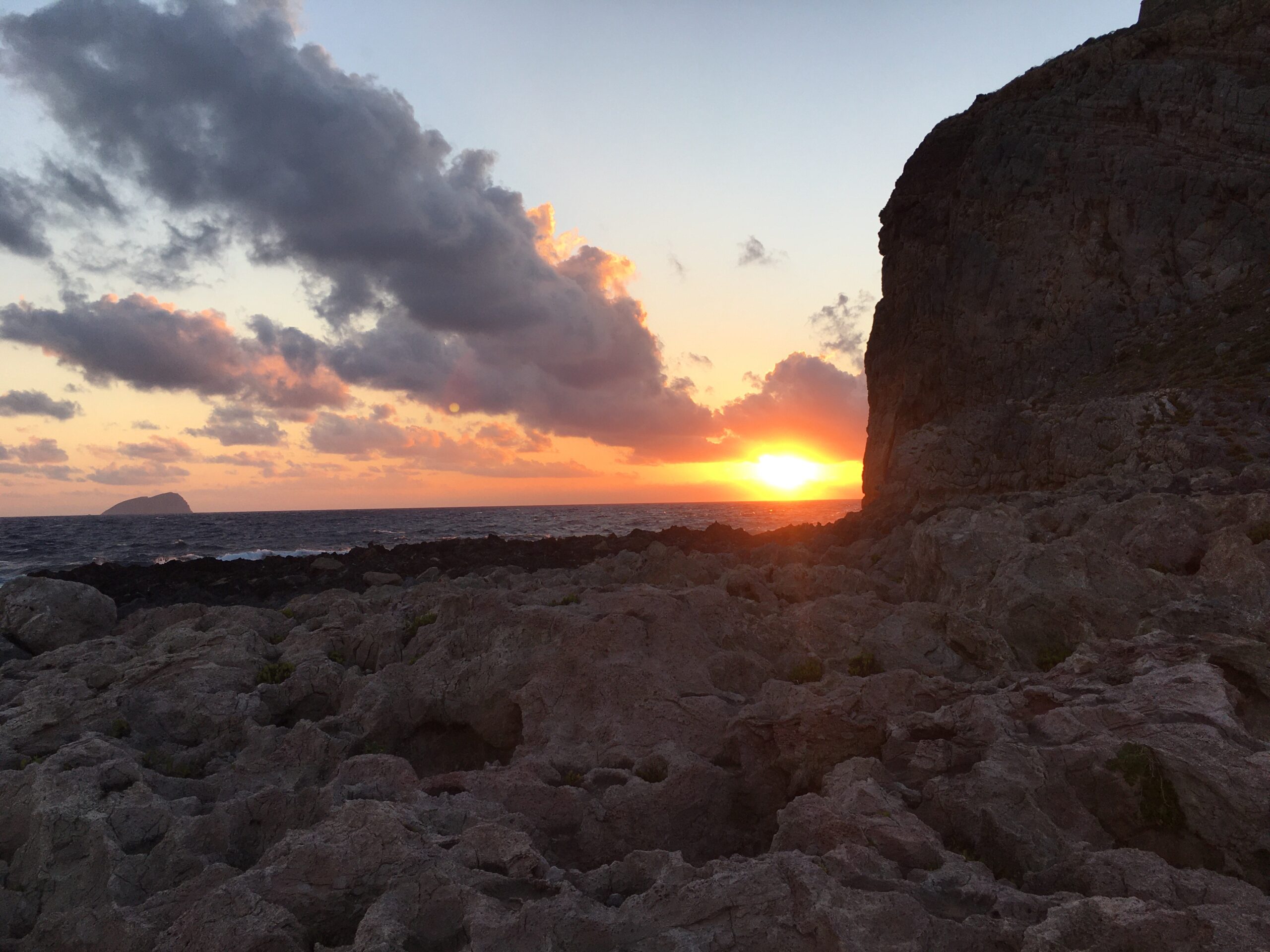
The only boats in the harbor for the night were us, a catamaran with a young family, a French boat with a man who was single-handing it and the care taker’s fishing/supply boat tied to the dock. We love experiences like this where tour boats depart for the day and we can walk alone on shore and take in the peaceful and comforting sounds of just nature. Water lapping on the rocks. Cicadas making a racket that really should be coming from an insect 20 times their size. The wind blowing through boat riggings, across hilltops and amongst scrub brush which, by the fragrance, must be wild thyme, sage and other wonderful herbs. Birds in flight and diving to grab a small fish that got too close to the water’s surface. In a place like this, what we are able to observe is little different from that which was seen by humans who walked on this land hundreds of years ago. The one obvious difference is the presence of an island care-taker instead of soldiers who would be on the look-out for approaching pirates or enemy nations.
The caretaker has a simple, solar powered home which sits just back from the beach and is tucked into the hillside and next to the path that climbs steeply to the fortress above. Tonight, the caretaker’s porch was filled with a happy group of Greek men. I can imagine a guy’s weekend that was weeks in the planning stage to get to this particular Saturday night. They were certainly enjoying themselves and we would hear them into the wee hours … singing Greek songs, laughing and clearly harassing one another.
While enjoying my morning coffee, I found it hard to stop looking at the hilltop citadel, the steep, cloud-covered mountains in the distance and water of multiple shades of blue surrounding our boat. Rustic beauty. The morning light called for a drone flight. Afterward, we took advantage of the conditions which were likely to be somewhat calmer than those later in the day to dinghy over to the southern bay. The tourist boats stop there as well and an attraction is the adjacent lagoon. Because the mountains are so tall, the perspective from our anchorage made it feel that the bay to our south was much closer than it actually was. The ride was long and quite rough, but we were here now so we walked around the waterfront and the lagoon and snorkeled a bit before setting out for the even rougher dinghy ride back.
We quickly changed into dry clothes so we could get up into the citadel before any of the day tripper boats arrived. The expansive views were captivating. Tom again flew the drone while I took some still shots and ground based video. Even from these heights, we continued to be out of cell phone coverage. Darn it, we wouldn’t be able to update our weather forecast data.
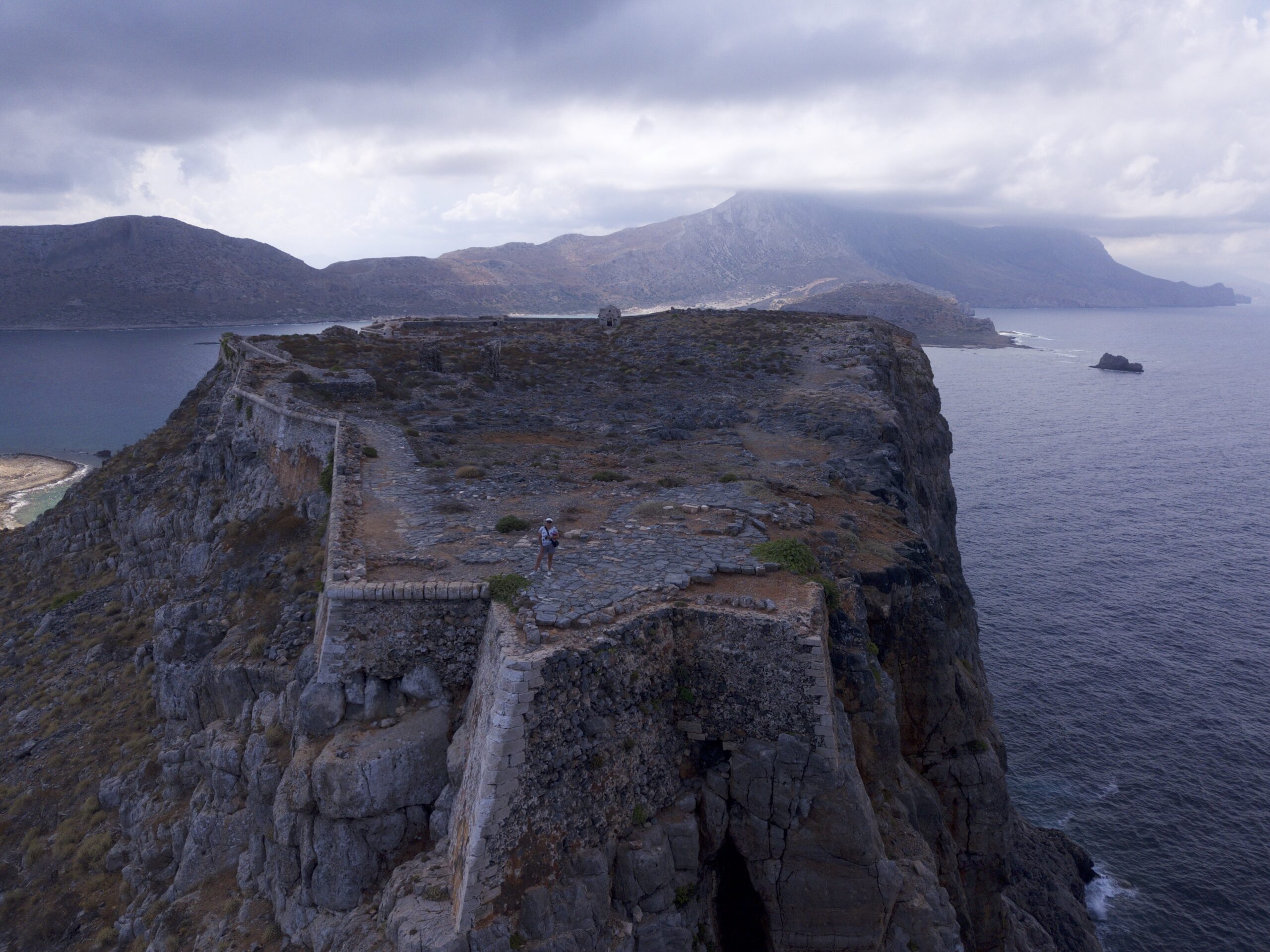
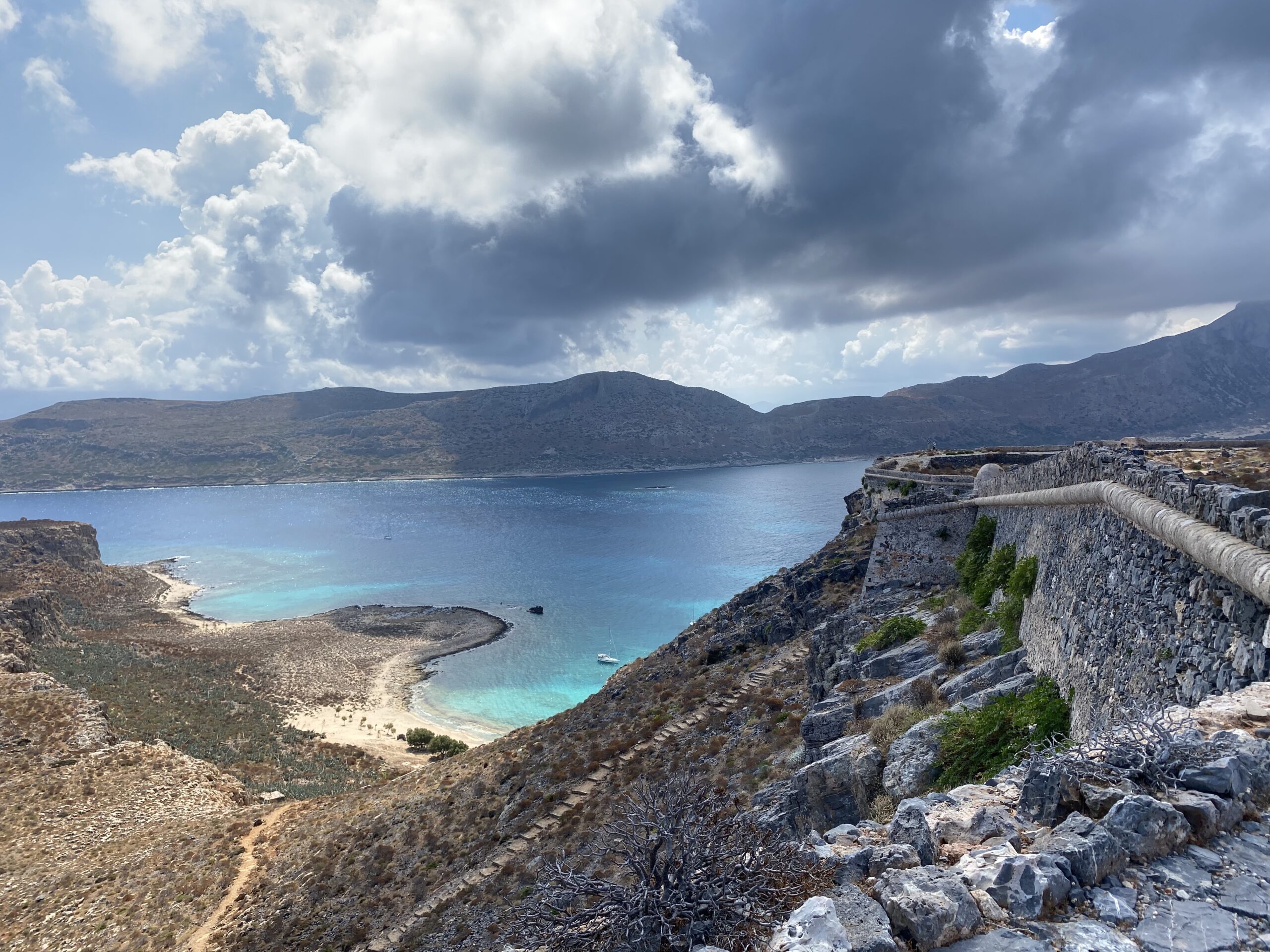
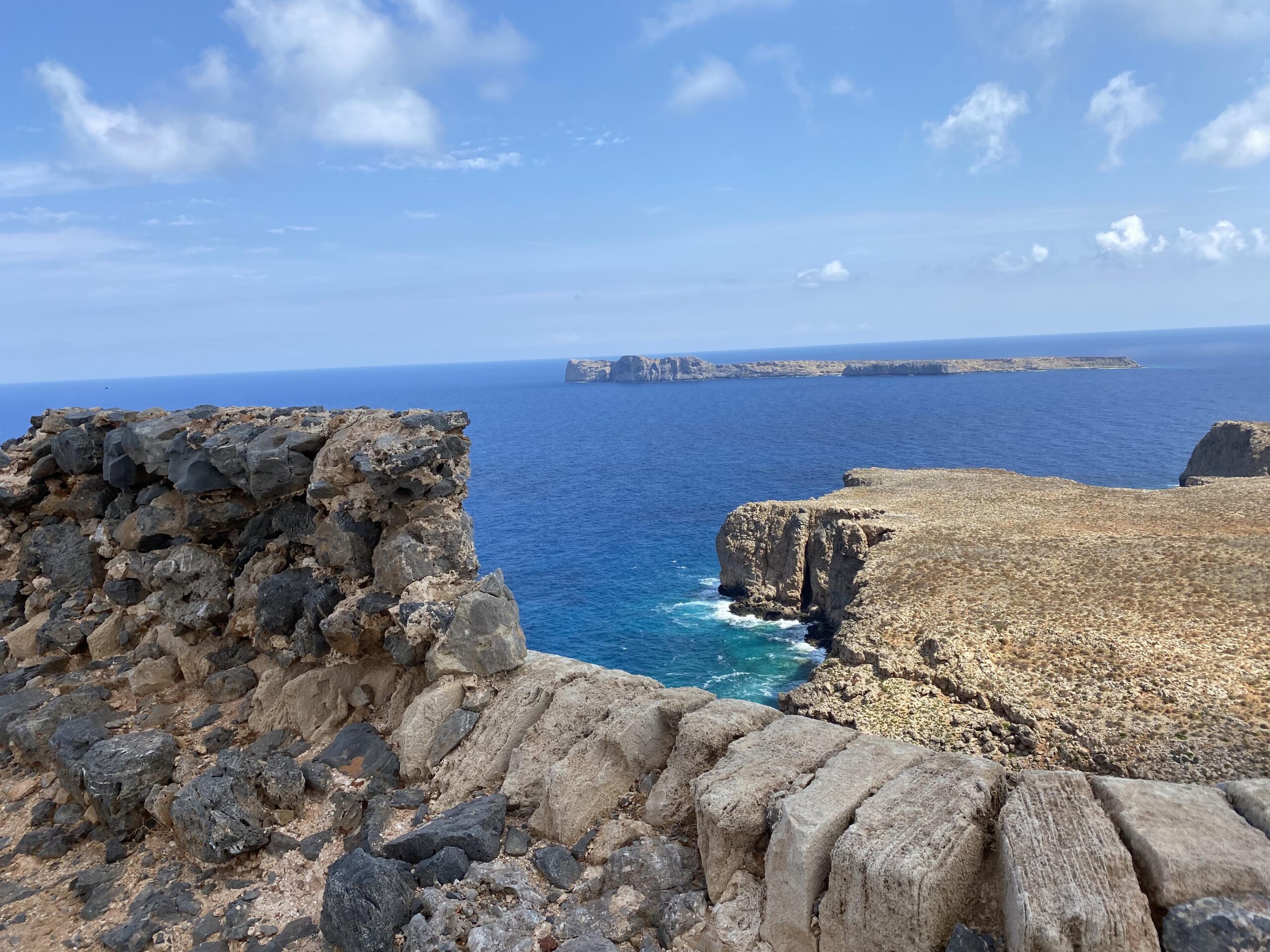
This fort was built between 1579 and 1584 by the Venetians during their rule of Crete in order to protect the island from the Ottoman Turks. It remained Venetian hands until 1691.
As we descended the steep path from the hilltop fortress, we noticed the first of the previous night’s boisterous men milling about. I’m happy they had a great night, the evidence of which is still playing out as they trudge toward the beach with their bath towel slung over a shoulder at a little before 1 pm! The caretaker must work hard, however, since he keeps the grounds in near-perfect condition. The path and signs were freshly painted, no garbage could be seen and the trees and plants seemed well cared for. I can understand the appeal of living for a season on an island. The solitude would allow for cleansing meditation and the grounds plus the lovely harbor provided an ever changing view.
The heat of the day was now upon us so it was a perfect time to swim over to the nearby shipwreck! The entire wreck was in less than four meters of water, and the water was calm enough to be able to snorkel all around the disintegrating ship. This wreck has been in these waters since January of 1968. The captain was taking 440 tons of cement from Central Greece to the North of Africa when winter weather deteriorated and they sought shelter in this protected area. They had put out two anchors but one chain broke in the heavy seas and though the captain tried to keep the ship off of the rocks with the ship’s engine, he ultimately wasn’t successful. Everyone was able to get safely to land, but the ship would not move again. The photos below show what the ship looks like today, both above and below the waterline.
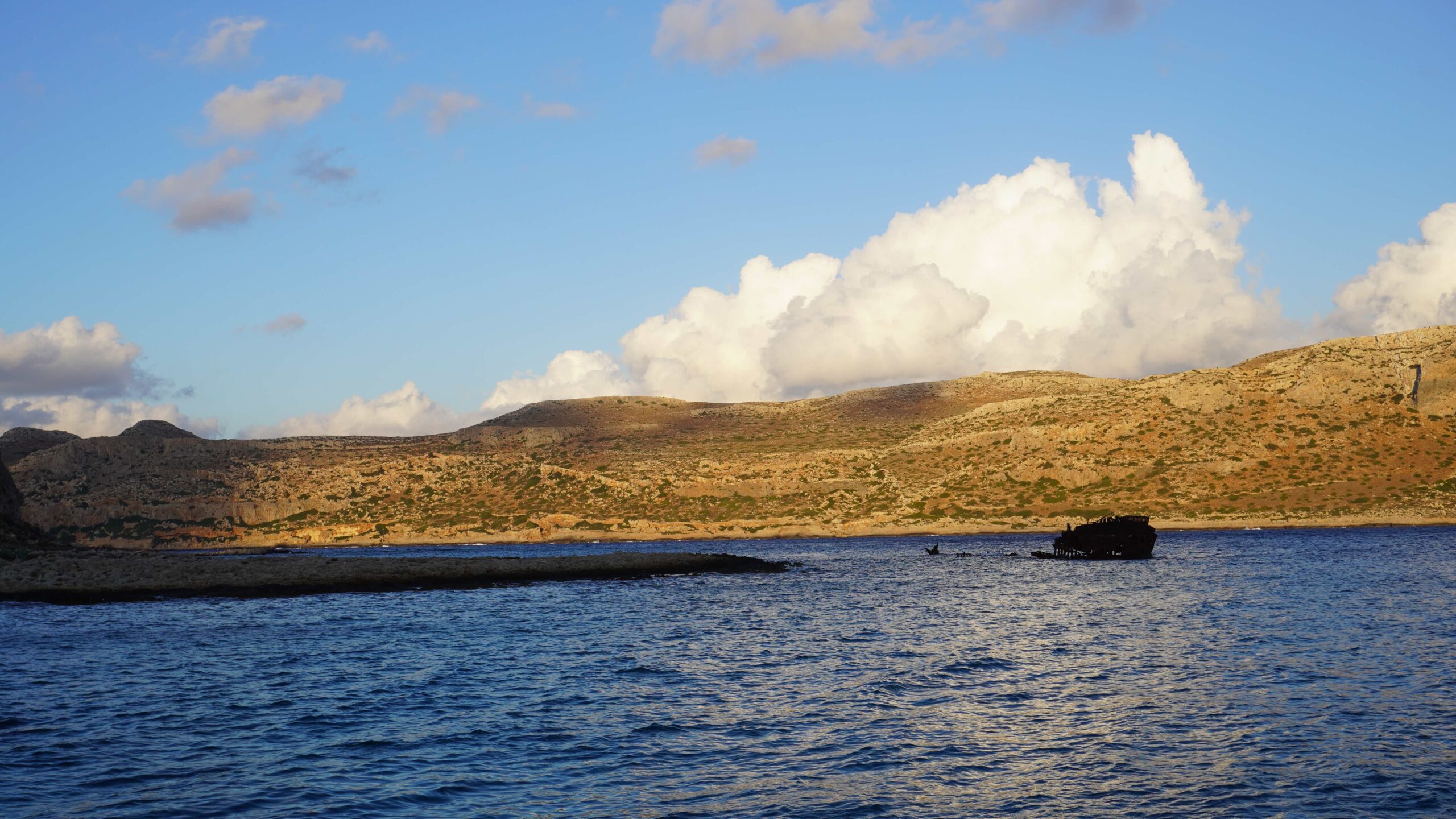
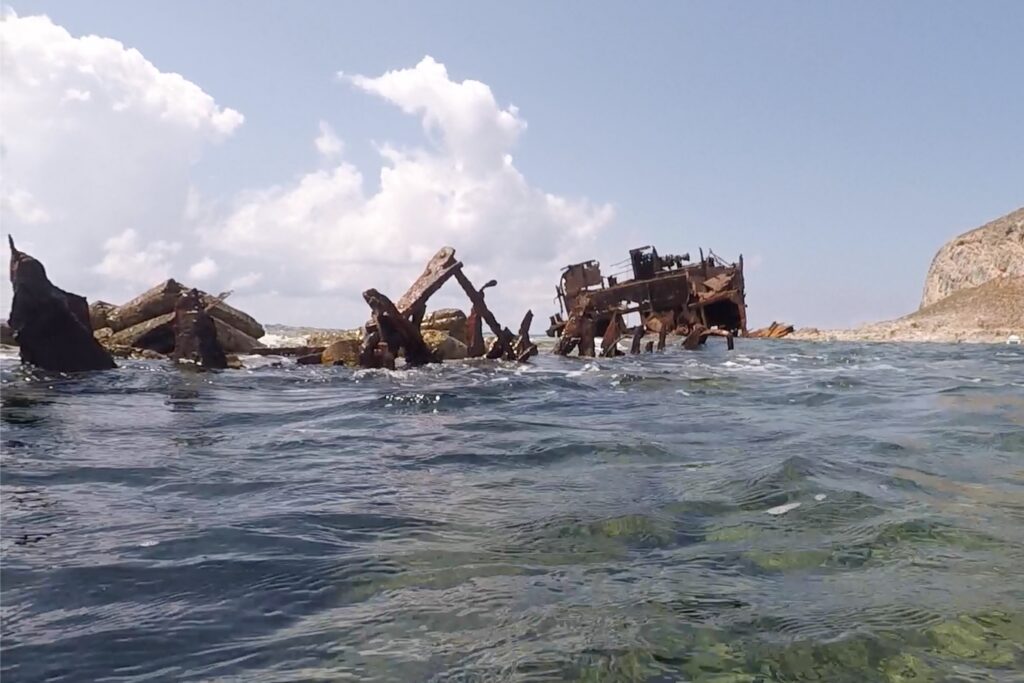
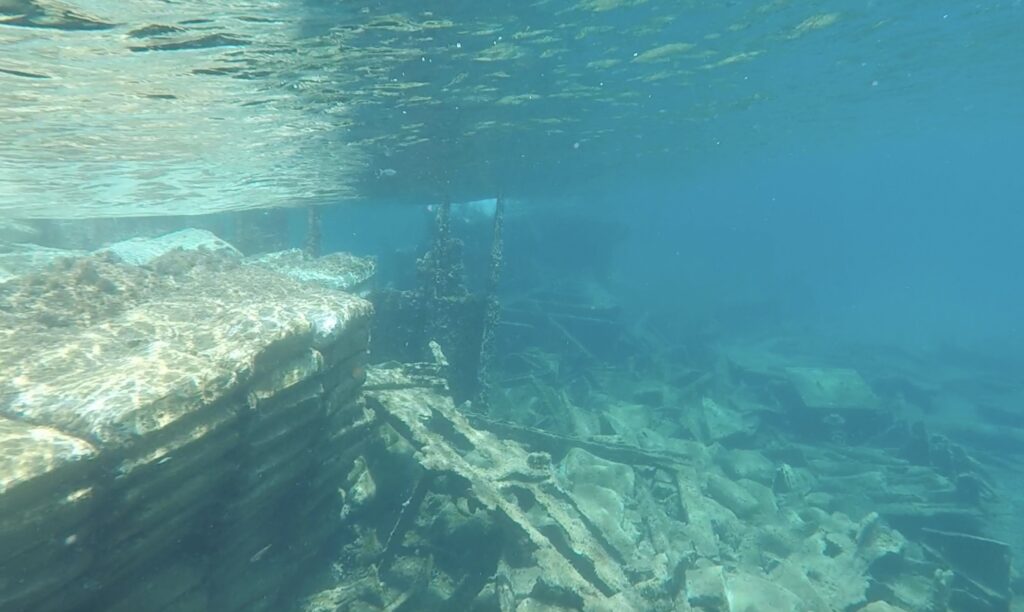
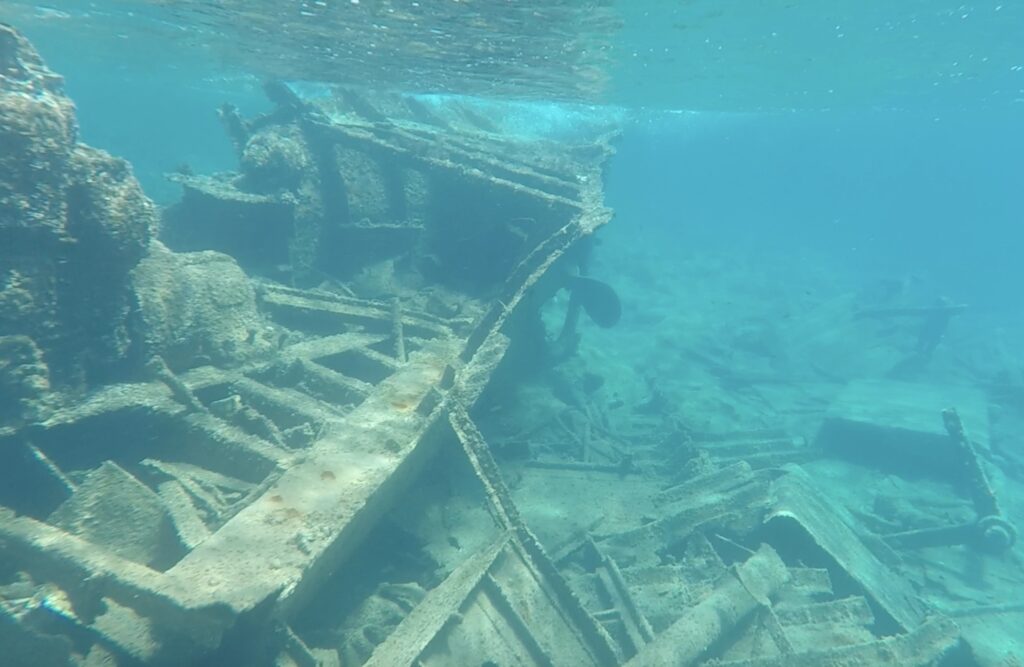
This article describes the wreck in greater detail and shows some photos of the wreck over time.
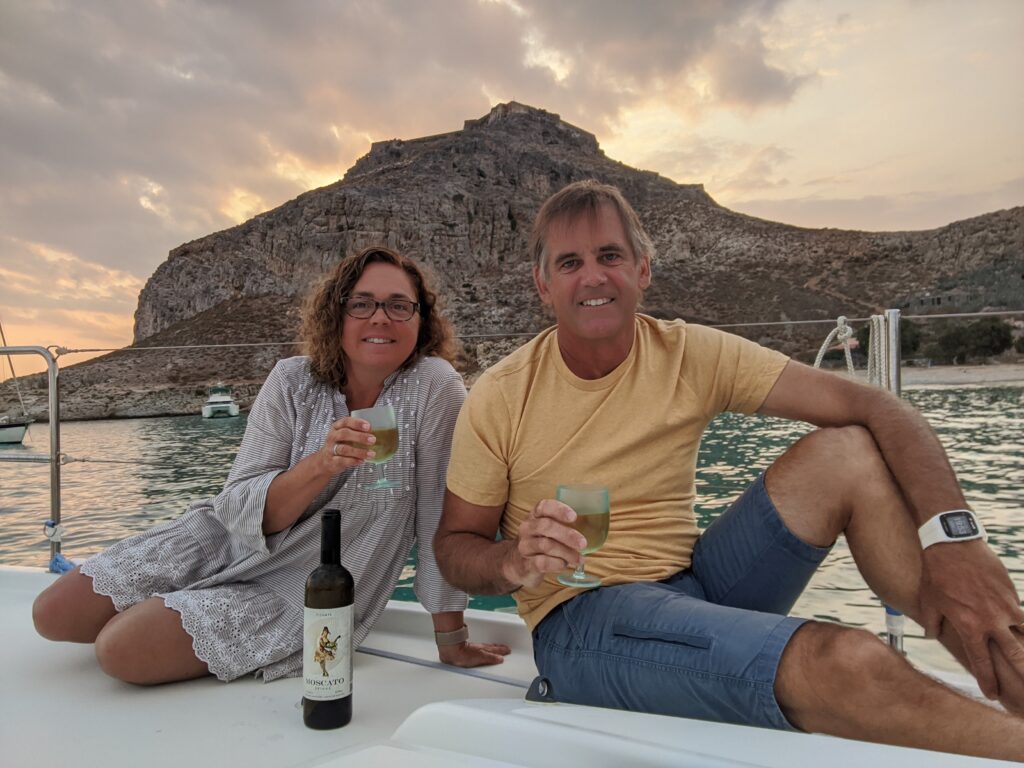
What a full day at a special place. As dusk approached, we again had the harbor nearly to ourselves. We planned to leave early the following morning and we also anticipated the overnight winds to kick up so we called it a day shortly after nightfall. Sure enough, we both woke up around 4 am to the sound of a building wind. A quick check showed us that our anchor was holding fine and the surrounding boats were swinging on their anchors at acceptable distances to us. Still, we slept lightly from that point onward as is typical when trying to sleep through changing conditions!
Our next destination was the island of Kythira, 42 nautical miles almost due north from our anchorage on the northwest tip of Crete. The last weather forecast we saw showed a good weather window to make the passage to Kythira right after our second night on anchor off Gramvousa. That was today! The seas in this area are often unsettled because of colliding weather patterns and the complex geography of steep land masses surrounded by the intersection of the Ionian Sea, the Aegean Sea and the sea south of Crete.
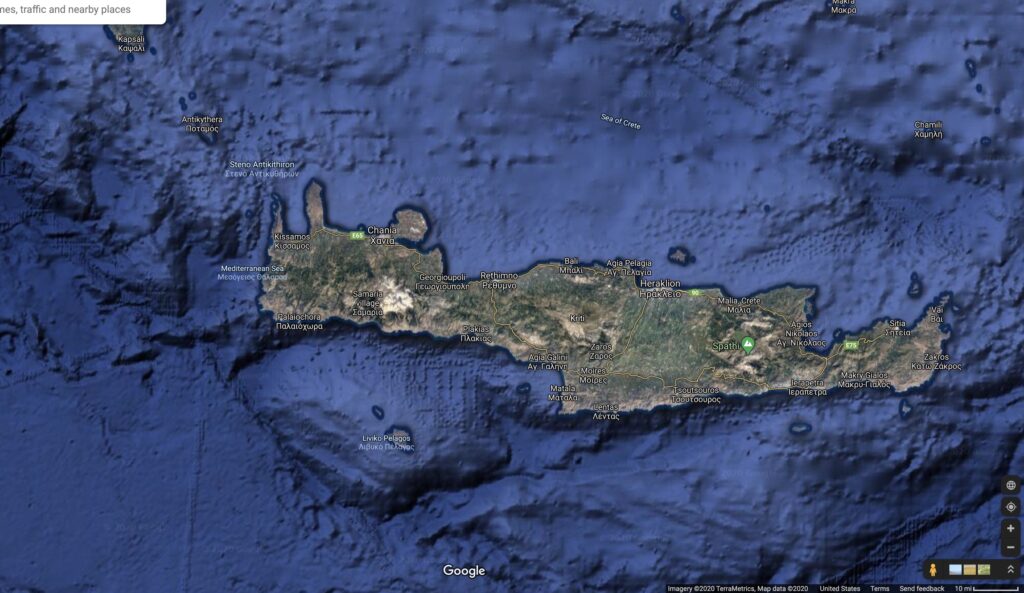
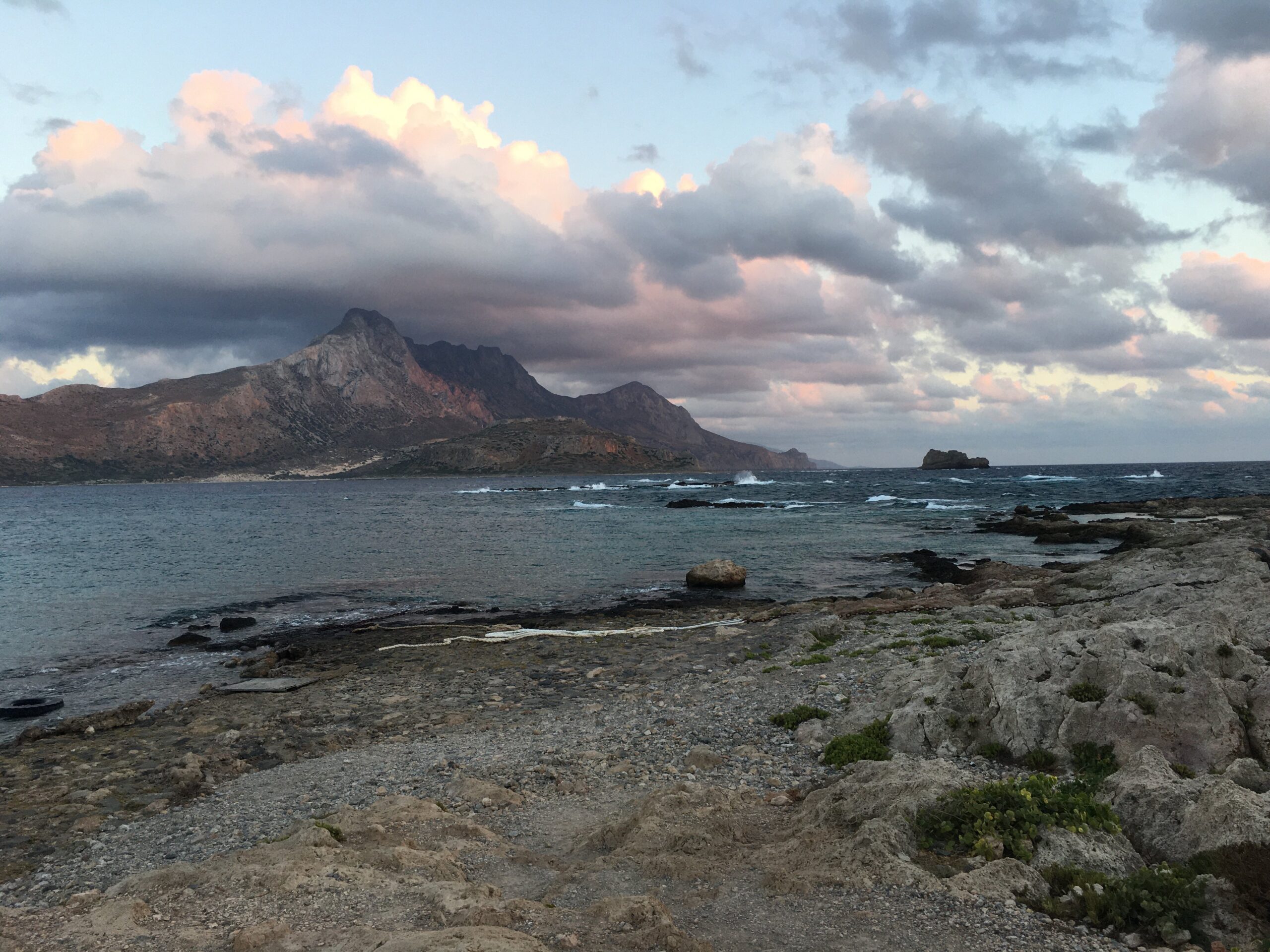
We had been nervous about this crossing from the moment we decided to venture down to Crete. Now, the previous several days had been windy which was surely producing significant swell patterns in the sea. This knowledge combined with our inability to get an updated forecast caused anxiety in both of us. However, we needed to make our move so we prepared for heavy winds and seas by securing the boat the best we could and rigging up our storm jib sail. Our storm jib is a small but rugged sail that we hoist on an inner forestay, bringing the wind-induced pressure on our rigging closer to the center of the boat. This sail plan is not only better for the rigging (mast, shrouds and spreaders), but it also allows for easier steering of the boat. When you have too large of a sail far forward on your foredeck, your bow is pushed excessively hard causing the boat to want to turn down wind. This puts undue pressure on your rudders and steering mechanisms as you essentially have to fight with the helm to keep the boat on course. The storm jib plus two reefs in our mainsail was the perfect sail configuration for this day! Steering didn’t take a lot of muscle which meant the pressure on sails in front of and behind the mast and keel (ie the center of the boat) were in balance. We were healing enough to help us cut through the large swells without too much slamming and we were able to keep an ok boat-speed. Still, the tough conditions require constant vigilance and it was turning out to be an 8 hour trip.
On to Peloponnesus!


Love these descriptions and that’s a great photo of you two with the Muscatel.